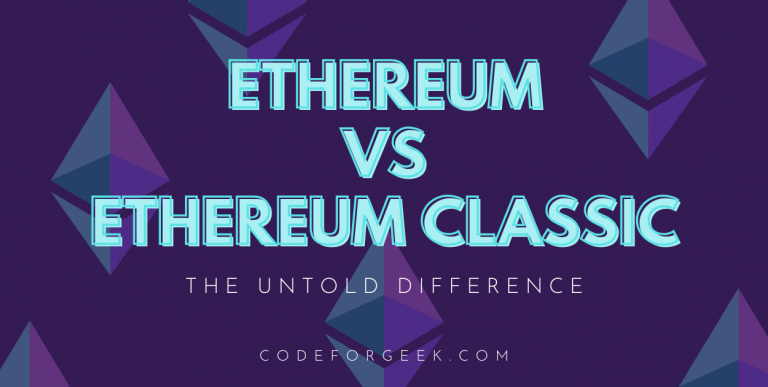Today I am introducing you to what most of you already know, Ethereum. Heard about Ethereum Classic too you say? Let me clear it all out for you with this Ethereum vs Ethereum Classic guide!
So, let’s started with this perplexing topic, made simple and easy just for you – Ethereum vs Ethereum Classic.
Let us first understand what both these mean, what they help in, and how they work. I will also explain a few related concepts and terms to help us understand everything of this Ethereum vs Ethereum Classic blog, better.
What is Ethereum?
First founded in 2015 by Vitalik Buterin, Ethereum is just one of the thousand cryptocurrencies that launched over the past few years. Its platform is known as Ethereum and a single unit of the coin is called an Ether.
While I write, 1 Ether (ETH) is valued at ₹2,33,895.6 (INR) that is worth $3,174.9 (USD).
Okay so let’s get to the real explanation.
Ethereum is a blockchain network meaning, a network of repeated distributed ledgers of transactions that are operated on a decentralized network of computers. These, help to manage and track the Ethereum cryptocurrency.
Like every blockchain network, the Ethereum blockchain network too, stores a copy of every information associated with a transaction (a receipt), this decentralized network of computers, across the globe, that is almost impossible to change or tamper with.
The data stored is highly secure in a way that, if at all anyone tries to tamper or change the information, all these computers must first verify and agree or disagree with them, ensuring the integrity of the data.
Learn more about cryptocurrency blockchain here.
It enables users to make transactions without the need and presence of any central intermediaries or middlemen such as a bank. The currency is thus autonomous due to the lack of a central bank.
Users can also exchange currencies almost anonymously although the details of those transactions are still available publicly on the blockchain.
However, Ethereum is mostly referred to as a cryptocurrency. As a technology, it is doing a lot more. Let us take a look.
Understanding Ethereum as a Technology
Ethereum is a community-built technology that is powerful enough to generate potential applications offering a wide range of functions:
Currency Wallet – Ethereum offers a cryptocurrency wallet that allows you to send and receive Ether (ETH) or pay for your favorite products if they accept digital currency as payments.
Smart contracts – A smart contract is a decentralized application stored on a blockchain. They run when predetermined conditions are met and are commonly used to automate the execution of an agreement.
Decentralized apps, or dApps – Ethereum powers decentralized apps that exist on blockchains or a P2P network of computers. They allow users to securely play games, invest, send money, follow social media, and a lot more.
non-fungible tokens – Using smart contracts, NFTs can be driven by Ethereum allowing artists or others to sell art, music, videos, or other kinds of collectibles directly to buyers, without any intermediaries.
Decentralized finance – Using Ethereum enables people to bypass the centralized (government) control or interventions by other bodies like banks, etc., that hamper the movement of money or other assets.
Decentralized Autonomous Organizations (DOAs) – These are safe member-owned communities without any centralized leadership. The decisions are governed solely by voting and proposals so everyone can have their voice.
Ethereum vs Ethereum Classic: The Untold Difference
Now that we explored quite a lot of information on Ethereum, let us finally talk about Ethereum vs Ethereum Classic.
An Overview
As an introduction, Ethereum Classic is an open-source, decentralized, shared cryptocurrency platform based on blockchain running smart contracts. However, it has a dire history. Back in 2016, there was a hack in the network that resulted in the formation of the Ethereum Classic blockchain.
Eventually, the original blockchain network was split in two; Ethereum Classic being the original blockchain network and Ethereum being the newer one.
The History
Initially, the Ethereum blockchain was recognized as one blockchain network facilitating transactions using Ether (ETH). However, that was only until the June of 2016.
Back then, the Ethereum blockchain network saw an enormous hack that stole funds worth $50 million, within one year of its inception, which was obviously embarrassing and disappointing.
As a solution, the split or a hard fork was performed which gave birth to Ethereum Classic and Ethereum blockchains. The split aimed at paying back the stolen funds to the owners based on the records before the hack.
The Difference
Gradually, as time passed, Ethereum gained more popularity for its legitimacy so much that today, it is the largest cryptocurrency after Bitcoin. People still are not able to place their long-lost trust in Ethereum Classic yet.
Ethereum Classic offers smart contracts however, one of its chief concerns is scalability, which remains even after multiple upgrades. Generally, Ethereum Classic can only deal with 15 transactions per second which is way too little because payment networks like Visa are already handling thousands of transactions per second.
Because cryptocurrencies have a decentralized nature, regulations may or may not affect them. Many crypto players face challenges getting inclusion approval in various financial products because they are not considered securities.
Going forward, uncertainty remains an issue with not just Ethereum Classic but most unrecognized blockchain networks.
Talking about Ethereum, it is considered the most legitimate and widely traded crypto today. Earlier this year, the Chicago Mercantile Exchange approved only Bitcoin and Ethereum for Ether Futures.
The futures contracts are basically derivative contracts on rudimentary security with a fixed price and date of maturity. Ether futures enable investors to trade ether (ETH) for supposition but also to secure an outstanding position in Ethereum or perhaps other cryptocurrencies.
Most importantly, Ethereum launched the Decentralized Autonomous Organizations (DAOs) project back in 2016, which are member-owned communities without central leaders like CEOs and allows investors to pool their funds with Ethereum-based DAO tokens.
Unfortunately, DAOs were the result of the 2016 hack that sprouted the two schools of thought. However, today, DAOs are made highly secure.
With this, the ultimate discussion on Ethereum vs Ethereum Classic ends.
Conclusion
Today I am introducing you to what most of you already know, Ethereum. Heard about Ethereum Classic too you say? Let me clear it all out for you with this Ethereum vs Ethereum Classic guide!
Noteworthy References
- What is Ethereum – BankRate
- What is Ethereum – Ethereum.org
- Cryptocurrency Blockchain – CodeforGeek
- Smart Contracts – CodeforGeek
- DAOs – Ethereum
- Ethereum vs Ethereum Classic – Investopedia





